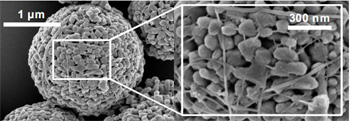Sep 4 2011
Toyohashi Tech researchers develop a low cost and efficient method for producing electrically conducting composites based on electrostatic adsorption of CNTs onto resin and ceramic particles for applications including the production of enzymes and cosmetics.
Hiroyuki Muto and colleagues at Japan's Toyohashi University of Technology (Toyohashi Tech) have developed an innovative method for producing CNT (carbon nano-tube) resin composite material [1] that only requires 1/100 [2] of the conventional amount of CNT additive to produce electrical conductivity in the composite material.
 Ceramic particles with electrostatically attached CNTs fibers.
Ceramic particles with electrostatically attached CNTs fibers.
In this method, CNTs were mixed in an electrolyte solution and added to the composite, where the CNTs were adsorbed onto the surfaces of the resin particles due to electrostatic adsorption [3]. This innovative procedure enabled the production of electrical conducting composites by the addition of a small quantity CNTs.
Importantly, the electrical conductivity of the composite material was easily controlled by changing the amount of electrolyte added to the composite; namely, the concentration of CNTs adsorption onto the resin particles.
Notably, this approach enables significant reductions in both the production costs and the production time compared with conventional methods for manufacturing conductive resins.
The researchers are confident that adding particles with charged surfaces will enable the production of a wide range of composite materials such as metals, ceramics, and polymers. This method is expected to find applications in the production of enzymes and cosmetics.
This work is supported by a Grant-in-Aid for Young Scientists at NEDO (New Energy and Industrial Technology Development Organization).
[1] This is a composite material comprising of resin particle with the addition CNTs. By utilizing the high conductivity of CNTs, practical products such as robust, anti-static components for clean rooms in the electronics industry, could be manufactured. The ability to control the electrical conductivity of the composite materials by this production method is expected to lead to a wide range of applications in the electronics industry, including use as alternatives for indium-tin-oxide transparent conductive film for displays, as plates for rechargeable batteries, and in semiconductor devices. Furthermore, the composite resin particles can be used in the production of for plastic materials, such as injection molding or extrusion.
[2] When imparting electrical conductivity to insulating ceramics or polymer materials, the introduction of conducting additive materials that can be linked within the resin structure is required. In conventional methods, the amount of additive is greater than 1% by weight. However, this new method only requires the addition of 0.01% CNT to impart conductivity.
[3] This method adsorbs CNTs onto the matrix resin particles by an electrostatic attractive force, which is a result of charging them positive or negative in appropriate electrolyte solutions. By controlling the concentration of the electrolyte solution added to the composite, the charge-volume of the surfaces of the particles can be changed, thus controlling the degree of adsorption of the CNTs.